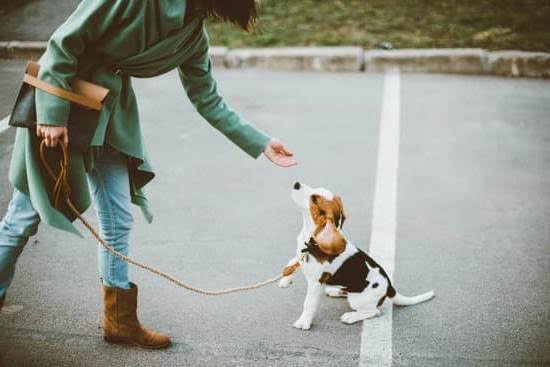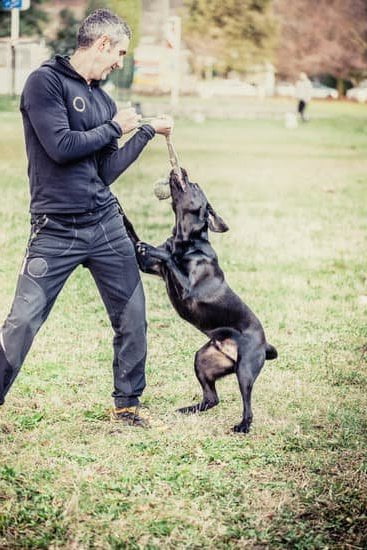In recent years, there has been a growing concern and debate about the impact of aversive training methods on dogs, particularly those who already experience anxiety. This article delves into the question: is aversive training okay with dogs that are anxious? In order to address this issue, it is crucial to first understand what aversive training entails and how it may affect anxious canines.
Aversive training methods involve the use of negative stimuli or punishment to modify a dog’s behavior. These techniques can range from physical corrections to verbal reprimands, and they have been used by many trainers for years. However, when it comes to dogs with anxiety, the potential consequences of such training methods need to be examined more closely.
Anxiety in dogs can manifest in various ways, including excessive barking, destructive behaviors, constant panting or trembling, and even aggression. Training sessions that implement aversive techniques may further exacerbate their anxiety and lead to detrimental behavioral issues. It is therefore crucial for dog owners and trainers alike to understand the potential dangers of using aversive training on already anxious canines.
By exploring alternative approaches such as positive reinforcement and creating a safe training environment, it is possible to address the needs of anxious dogs effectively while promoting their overall well-being. Seeking guidance from certified trainers and behaviorists who specialize in anxiety-related issues can also provide invaluable support. Ultimately, this article aims to raise awareness about the connection between aversive training and anxious dogs, highlighting the necessity of more compassionate approaches in improving their quality of life.
Understanding Canine Anxiety and its Manifestations
Canine anxiety is a common issue that many dog owners face, and it can have a significant impact on their overall well-being. In order to effectively address anxiety in dogs, it is important to first understand its causes and manifestations.
There are several factors that can contribute to canine anxiety, including genetics, past traumatic experiences, lack of socialization, or even medical issues. Some common symptoms of anxiety in dogs include excessive barking, destructive behavior, pacing, trembling, hiding, or even aggression. It is crucial for dog owners to recognize these signs in order to provide the necessary support and intervention.
When it comes to training anxious dogs, there can be additional challenges. These dogs may have a heightened sensitivity to various stimuli, making them more prone to fear-based reactions during training sessions. Loud noises, sudden movements, or even new environments can trigger their anxiety and hinder the learning process. As a result, it is essential for trainers and owners to approach training with patience, understanding, and tailored techniques that take the dog’s anxiety into consideration.
To ensure the well-being of anxious dogs during training sessions, it is vital to create a safe and supportive environment. This includes maintaining calm energy, using positive reinforcement techniques that reward desired behaviors instead of punishing unwanted ones. Anxious dogs often respond better to gentle guidance paired with treats or praise rather than aversive methods such as yelling or physical reprimands.
By understanding the causes and manifestations of canine anxiety and implementing appropriate training approaches for anxious dogs owners can help their pets overcome their fears and build confidence. Positive reinforcement provides a compassionate alternative that empowers anxious dogs while reducing their anxiety levels.
| Cause | Symptoms |
|---|---|
| Genetics | Excessive barking |
| Traumatic experiences | Destructive behavior |
| Lack of socialization | Pacing, trembling, hiding |
| Medical issues | Aggression |
In summary, understanding canine anxiety is crucial when it comes to training anxious dogs. By recognizing the causes and symptoms of anxiety, trainers and owners can implement appropriate and effective techniques that promote a positive learning experience for these dogs. The use of positive reinforcement and providing a safe training environment are key in helping anxious dogs overcome their fears and lead happier lives.
The Potential Dangers of Aversive Training for Anxious Dogs
Averse training methods, which rely on punishment and physical corrections, can have detrimental effects on anxious dogs. Dogs that already struggle with anxiety are at a higher risk of experiencing increased fear, stress, and anxiety when subjected to aversive techniques.
Aversive training can exacerbate their existing fears and lead to the development of new behavioral issues. It is crucial for dog owners and trainers to recognize the potential dangers of aversive training for anxious dogs and seek alternative approaches that prioritize their well-being.
When an anxious dog is exposed to aversive training methods, it can heighten their overall anxiety levels. This kind of training relies on punishment, which may involve yelling, leash jerks, shock collars, or other physically intimidating methods. Instead of addressing the underlying causes of anxiety in dogs, aversive techniques create a negative association between the stimulus or situation causing fear and pain or discomfort. Consequently, this can cause the dog to become even more fearful and anxious in those situations.
Furthermore, aversive training can lead to the development of new behavioral issues in anxious dogs. These methods often focus on suppressing undesirable behavior through punishment rather than teaching alternative behaviors using positive reinforcement techniques. Anxious dogs may resort to aggressive responses out of fear or frustration when faced with punishment-based training methods. This not only increases their stress levels but also creates additional challenges in their training process.
Alternative Training Approaches for Anxious Dogs
When it comes to training anxious dogs, it is crucial to avoid aversive training methods that may exacerbate their anxiety and lead to behavioral issues. Instead, implementing alternative training approaches that prioritize positive reinforcement can be highly effective in reducing anxiety and building a strong bond between the dog and their owner.
Positive reinforcement training focuses on rewarding desired behaviors rather than punishing unwanted ones. This approach involves providing treats, praise, or other rewards when the dog displays the desired behavior, which helps them associate the behavior with a pleasant outcome. Research has shown that dogs trained using positive reinforcement methods are more motivated, exhibit fewer signs of fear or stress during training sessions, and develop better problem-solving skills.
One popular technique used in positive reinforcement training is clicker training. This method involves using a handheld device called a clicker that makes a distinct clicking sound when pressed. The trainer clicks the device at the exact moment the dog performs the desired behavior, followed by immediately rewarding them with a treat or praise. Over time, the dog learns to associate the click with receiving a reward, making it easier for them to understand what behaviors are being reinforced.
Implementing alternative training approaches for anxious dogs not only helps reduce their anxiety but also creates a positive and supportive learning environment. It is important to remember that each dog is unique, and what works for one may not work for another. Patience, consistency, and understanding are key when using these alternative methods as they allow anxious dogs to build confidence and trust while learning new behaviors.
In summary, aversive training techniques should be avoided when working with anxious dogs as they can worsen anxiety-related issues. Implementing alternative approaches such as positive reinforcement training techniques like clicker training can effectively reduce anxiety levels in dogs while promoting a healthy learning experience. By creating an environment of patience and understanding, owners can help their anxious pets gain confidence and enjoy their training sessions.
| Training Approach | Benefits |
|---|---|
| Positive reinforcement training | – Motivates dogs and reduces fear or stress during training
|
| Clicker training | – Helps dogs understand desired behaviors through association
|
Recognizing Signs of Anxiety in Dogs during Training Sessions
Identifying behavioral cues that indicate anxiety in dogs
During training sessions, it is crucial for dog owners and trainers to be able to recognize the signs of anxiety in their canine companions. By being aware of these cues, appropriate measures can be taken to ensure the well-being of the anxious dog. Some common behavioral cues that indicate anxiety in dogs include:
- Panting and drooling excessively: Dogs may start panting heavily or drooling excessively when they feel anxious. This can be especially noticeable during training sessions where they are faced with aversive techniques.
- Trembling or shaking: Anxious dogs may exhibit physical signs such as trembling or shaking during training sessions. This involuntary response is a clear indication of their distress.
- Avoidance behaviors: Dogs that are anxious may try to avoid certain training exercises or situations altogether. They may cower, hide, or try to escape from the training area, signaling their discomfort.
- Abnormal body language: Pay attention to changes in your dog’s body language during training sessions. If they display a lowered tail, pinned ears, or a hunched posture, it could be an indication of anxiety.
Providing guidance on how to handle anxious reactions during training
When a dog shows signs of anxiety during a training session, it is essential for owners and trainers to respond appropriately and compassionately in order to prevent further stress and potential negative effects on their overall mental well-being. Here are some guidelines for handling anxious reactions during training:
- Stay calm and patient: It is important for both the trainer and the owner to remain calm and patient when dealing with an anxious dog. Reacting with frustration or impatience can increase their anxiety levels.
- Take breaks as needed: If you notice your dog becoming increasingly stressed or overwhelmed, take regular breaks during the training session to allow them time to relax and decompress.
- Modify training exercises: Adapt the training exercises to suit your dog’s anxiety levels. Break down complex tasks into smaller, manageable steps and gradually progress as they become more comfortable.
- Provide positive reinforcement: Use positive reinforcement techniques such as treats, praise, and play to reward your dog for their calm and successful responses during training. This will help build their confidence and reduce anxiety.
- Seek professional guidance if necessary: If you are unsure about how to handle your anxious dog’s reactions during training, consider seeking the help of a certified trainer or behaviorist who specializes in working with anxious dogs.
By recognizing signs of anxiety in dogs during training sessions and responding appropriately, owners and trainers can create a safe and supportive environment that promotes learning while addressing and reducing the anxieties their canine companions may experience throughout the process.
Creating a Safe and Enriching Training Environment for Anxious Dogs
Importance of a calm and supportive atmosphere
When it comes to training anxious dogs, creating a safe and enriching environment is essential. Dogs that are already prone to anxiety can easily become overwhelmed and stressed during training sessions if the environment is chaotic or intimidating. It is crucial to provide them with a calm, supportive atmosphere where they can feel secure and comfortable.
To achieve a peaceful training environment, it is important to eliminate any potential stressors. This includes reducing noise levels, minimizing distractions, and ensuring that there are no triggers that may cause anxiety for the dog. Additionally, maintaining a consistent routine and structure can help anxious dogs feel more at ease during training sessions.
Tips for setting up a stress-free training area
Creating a stress-free training area for anxious dogs involves several key considerations. First and foremost, the physical space should be quiet and free from excessive noise. This could mean choosing a designated room in the house away from high-traffic areas or utilizing soundproofing techniques to minimize outside distractions.
In addition, it can be beneficial to use calming aids such as pheromone diffusers or natural aromatherapy sprays to create a soothing environment for the dog. These products can help reduce anxiety and promote relaxation during training sessions.
Furthermore, providing comfortable bedding or blankets in the training area can offer a sense of security for the dog. Having familiar scents and textures nearby can help alleviate anxiety and make the dog feel more at ease.
Supportive handling techniques
Another crucial aspect of creating a safe training environment for anxious dogs is using supportive handling techniques. This involves approaching each session with patience, understanding, and compassion. Forceful or harsh methods should be avoided as they can increase fear and anxiety in these sensitive animals.
Instead, trainers should focus on positive reinforcement techniques that reward desired behaviors. Using treats, toys, or praise as rewards can motivate anxious dogs and make the training experience more enjoyable for them. It is important to remember that building trust and confidence through positive interactions is key to success with anxious dogs.
By providing a calm and supportive environment, trainers can help anxious dogs feel more comfortable during training sessions. This will not only enhance their learning experience but also contribute to their overall well-being and happiness.
Professional Help
When it comes to training anxious dogs, seeking professional help can make a world of difference. Certified trainers and behaviorists specialize in understanding canine behavior and can provide valuable guidance and support throughout the training process. Their expertise can help mitigate anxiety and ensure a more positive experience for both the dog and their owner.
The significance of seeking professional guidance
Certified trainers and behaviorists have the knowledge and skills necessary to address the specific needs of anxious dogs. They are able to assess the root causes of anxiety in dogs, identify triggers, and develop personalized training plans tailored to each individual dog’s needs. This level of specialized expertise is crucial in creating a safe and effective training environment that promotes trust, confidence, and overall well-being.
Techniques used by trainers and behaviorists
Trainers experienced in working with anxious dogs often rely on force-free, positive reinforcement techniques. These methods focus on rewarding desirable behaviors rather than punishing undesirable ones. Positive reinforcement not only helps reduce anxiety levels in dogs but also strengthens the bond between the dog and their owner.
Trainers may use treats, toys, or praise as rewards during training sessions to reinforce desired behaviors such as sitting or staying calm in anxiety-inducing situations. By consistently rewarding positive actions, anxious dogs learn to associate certain situations with positive outcomes, ultimately reducing anxiety over time.
Additionally, trainers may implement desensitization techniques to gradually expose anxious dogs to feared stimuli in a controlled manner. This method involves slowly introducing triggers at a manageable intensity while using positive reinforcement techniques simultaneously. With patience, consistency, and guidance from certified professionals, anxious dogs can gradually acclimate to their triggers without experiencing overwhelming fear or anxiety.
Seeking professional help when training an anxious dog is essential for both their well-being and progress during training sessions. Trainers certified in working with anxious dogs have the knowledge and experience to address the specific needs of these animals, utilizing positive reinforcement techniques to alleviate anxiety and promote a more positive training experience. With professional guidance, owners can effectively help their anxious dogs overcome their fears and thrive in a calm, supportive, and loving environment.
Case Studies
Positive training methods have shown remarkable success in helping anxious dogs overcome their fears and anxieties. By focusing on reward-based techniques, these methods aim to empower and build the confidence of anxious canines, ultimately leading to improved behavior and a higher quality of life. Let’s explore some inspiring case studies that highlight the transformational effects of positive training on anxious dogs.
- Bailey: A rescued dog suffering from separation anxiety Bailey, a lovable mixed breed, came into a rescue center exhibiting severe separation anxiety. The dedicated trainers at the center used positive reinforcement techniques to gradually acclimate Bailey to being alone.
They started by rewarding calm behavior when her humans left and returned home, eventually increasing the duration of their absence while ensuring Bailey felt safe and secure. With consistent training and support, Bailey’s anxiety decreased over time, allowing her to enjoy longer periods without distressing symptoms. - Teddy: A reactive dog with fear-based aggression Teddy, a fearful Labrador Retriever, struggled with fear-based aggression towards other dogs due to previous negative experiences. His owners worked closely with a certified trainer who employed positive training methods to modify his behavior.
Through gradual exposure to controlled situations and systematic desensitization exercises, Teddy learned alternative behaviors such as sitting or focusing on his owner when encountering other dogs. Over time, he became more confident and less reactive until he was able to calmly coexist with other dogs in social settings. - Luna: An anxious puppy with noise sensitivity Luna, a young Border Collie mix, displayed extreme fear and anxiety during thunderstorms or fireworks displays due to noise sensitivity. Her owner sought help from an experienced behaviorist who utilized positive reinforcement techniques combined with counterconditioning exercises.
Gradually exposing Luna to recorded sounds at low volume while offering treats and praise helped her associate noises with positive experiences rather than fear or anxiety. As a result, Luna’s sensitivity decreased significantly, enabling her to cope better with loud noises and enjoy calm and relaxed behavior during previously distressing events.
These real-life success stories demonstrate that positive training methods can effectively alleviate anxiety in dogs, leading to lasting behavioral improvements. By focusing on building trust, confidence, and positive associations, anxious dogs can thrive in training scenarios and overcome their fears. It is essential for owners to remember that each dog is unique, so tailored approaches should be employed based on individual needs and circumstances.
In the next section, we will explore how to identify signs of anxiety in dogs during training sessions and provide guidance on how to handle these reactions with empathy and patience.
Conclusion
In conclusion, it is crucial to recognize that aversive training methods and anxious dogs do not mix well. As highlighted throughout this article, aversive techniques can have a detrimental impact on already anxious canines, exacerbating their anxiety and potentially leading to behavioral issues.
Instead, alternative training approaches such as positive reinforcement offer a more effective and compassionate way to address the anxiety in dogs. By rewarding desired behaviors and creating a positive association with training sessions, pet owners can help reduce their dog’s anxiety and enhance their overall well-being.
Creating a safe and enriching training environment is also essential when working with anxious dogs. Providing a calm and supportive atmosphere can go a long way in alleviating anxiety and ensuring successful training sessions. This includes setting up a stress-free area specifically designed for training and recognizing signs of anxiety in dogs to appropriately handle any anxious reactions.
Ultimately, seeking professional help from certified trainers or behaviorists is highly recommended when working with anxious dogs. These experts have the knowledge and techniques to guide pet owners in effectively training their anxious pets while taking into consideration their unique needs and challenges.
Frequently Asked Questions
How do you train a dog with high anxiety?
Training a dog with high anxiety requires a patient and understanding approach. Firstly, it’s crucial to create a safe and calm environment for the dog, minimizing triggers that may worsen their anxiety. Slowly introducing them to new situations or stimuli in a controlled manner can also help desensitize them over time.
Positive reinforcement techniques, such as rewarding good behavior with treats or praise, should be used to reinforce desired behaviors and build the dog’s confidence. Consistent training sessions with short intervals can help the dog focus and reduce stress. It is important to avoid punishment or harsh methods as these can further exacerbate their anxiety.
Does it matter whether dog training is positive or aversive?
The approach of dog training, whether positive or aversive, does matter significantly. Positive reinforcement techniques have proven to be more effective and humane in training dogs. By using rewards and praise, dogs are motivated to learn new behaviors willingly and associate these actions with positive experiences.
This strengthens the bond between the dog and the trainer while promoting a healthy learning environment. On the other hand, aversive training methods that involve punishment or intimidation can cause fear or aggression in dogs, worsening behavioral issues and damaging their trust towards humans. Ultimately, positive reinforcement-based training is not only more ethical but also produces better long-term results.
Can an anxious dog be rehabilitated?
Yes, an anxious dog can be rehabilitated with proper care, patience, and consistent training methods tailored to their specific needs. It is essential to consult with a professional trainer or behaviorist who specializes in working with anxious dogs to develop an individualized rehabilitation plan based on the dog’s triggers and limitations. Building up the dog’s confidence through positive reinforcement techniques helps them overcome anxiety-inducing situations gradually without feeling overwhelmed.
Adequate socialization is also key as it exposes the anxious dog to new environments, people, and animals under controlled circumstances allowing them to adapt at their own pace while feeling supported by their owner/trainer. With time and effort invested in their rehabilitation process along with a nurturing environment, anxious dogs can often overcome their fears and lead happy, well-adjusted lives.

Welcome to the blog! I am a professional dog trainer and have been working with dogs for many years. In this blog, I will be discussing various topics related to dog training, including tips, tricks, and advice. I hope you find this information helpful and informative. Thanks for reading!





